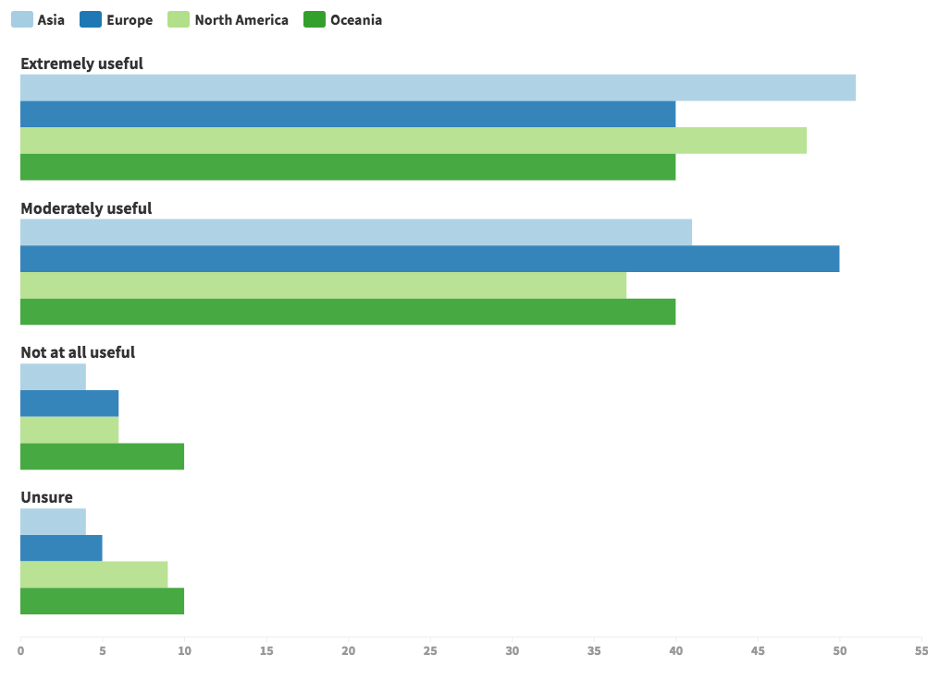In this article:
- What is RCS?
- Five ways RCS will up-end how businesses reach their customers and drive higher sales
- 1. Higher conversion rates
- 2. Reduce channel clutter
- Consumers want messaging simplified
- Would it be useful if all your mobile chats tool place using your phone’s default TXT/SMS application?
- 3. Real-time utility
- 4. Bypass muted notifications
- 5. Deeper metrics
After years of hearing “It’s coming!” Rich Communication Services (RCS) is finally a reality for many consumers. Google’s Android phones have it and Samsung users have the option to use it. Apple has not announced plans to adopt RCS, but pundits expect the move is all-but inevitable. For enterprise businesses wanting to lead with mobile experiences, RCS adoption is a game changer.
What is RCS?
RCS is a communication protocol used by mobile carriers that is the next-generation of SMS messaging. Up until recently, most of what takes place in your phone’s default messaging app is purely text-based (with a healthy sprinkling of emojis). With RCS, your smartphone’s native messaging app will support rich messaging features, making its default messaging stream look a lot more like WhatsApp, Messenger or Instagram Message. Many Android users are already experiencing what RCS is all about. RCS features include:
- [Most important!] App-like functionality: Users are no longer limited to simple text-based exchanges. Share a survey or assessment that can be filled out within the messaging stream. Change reservations, book tickets, make a purchase, update privacy settings--again, all without leaving the native phone messaging app
- Larger file sizes: Consumers and businesses can send larger file sizes, including GIFs, videos, hi-res photos, PDFs, etc.
- Text away! Similar to messaging apps like Messenger and WhatsApp, RCS has no character limits
For marketing and CX leaders, this shift is an enormous change in the mobile engagement landscape. Using RCS, companies can interact in new, interactive ways. Want to notify a customer a package is on the way? Rather than sending a simple, “your package is arriving today,” message, share a map that shows real-time updates and lets customers give specific instructions (e.g. “Leave it on my back porch, please!”).
Five ways RCS will up-end how businesses reach their customers and drive higher sales
1. Higher conversion rates
RCS gives businesses a chance to deliver highly personalized messages, in a format that’s much more interactive. And a better experience means higher conversion rates. Let’s look at some industry scenarios:
Travel: A hotel chain wants to notify customers about Valentine’s Day deals. Using SMS/TXT, the hotel can send a short text-only message plus hyperlink. Using RCS, the hotel can send photos of its promotion destinations with relevant pricing, develop insights about which promotions capture specific customers’ attention, and use the data to form a clearer 1:1 buyer journey. Once a customer reserves the deal, using RCS the hotel can offer additional deals--from room upgrades to champagne and roses waiting in the room.
Healthcare: A pharmacy wants to increase loyalty by helping its customers manage prescriptions. Using traditional texting, the chain reminds the customer a refill order is upcoming. “Do you want to fill your prescription for Metformin? Text yes or no.” Using RCS, the customer can manage all their prescriptions in the texting stream, turning on auto-refills and suspending others, and advising when they’ll be in to pick up the next refill.
Retail: A home goods chain wants to develop deeper relationships with its customers. Using SMS, it pushes out a notification of an upcoming sale. With RCS, the retail chain sends sale prices for a half-dozen products that the customer is most likely to covet based on analysis of their buying history - and gives customers a chance to purchase without leaving the texting stream.
Just how big is the performance jump from SMS to RCS? French insurance company Macif reports click-through rates on RCS to be 2x that of SMS, and 3x that of email.
2. Reduce channel clutter
Research from Sinch shows that consumers are enthusiastic about next-generation mobile messaging and, in particular, they find the idea of aggregating ALL messaging within their phone’s default inbox “extremely useful.” (See chart below.)
So, even while brands are busy multiplying the number of messaging channels they use to reach customers, consumers are suggesting they would like fewer channels.
Consumers want messaging simplified
Would it be useful if all your mobile chats tool place using your phone’s default TXT/SMS application?

3. Real-time utility
One of the key benefits of RCS is enabling companies to provide their customers with up-to-the-moment, real-time utility. Such as:
Rebooking a flight without the call center: Inbound calls to call centers are time consuming for the customer and costly for a business. Using RCS, customers can request changes to their itinerary and be send a new copy of the ticket or boarding pass directly to their inbox.
Targeting abandoned carts: Remind customers about incomplete checkouts by sending images of items they’ve left in their online carts and even let them complete their purchase from the inbox.
Increase delivery completions: Let customers know their package is on the way and provide them with selectable options for leaving in a safe place or scheduling redelivery, all without having to leave the inbox.
These types of interactions are valuable because they are, by nature, personalized. uniquely suited to a single individual. As Michael Ricci, Master Principal Solutions Architect for Oracle’s CX Center of Excellence, recently shared in Sinch’s Mobile Consumer Engagement 2020 report:
Without personalizing the customer experience, most consumers opt out. That’s the biggest challenge: helping brands understand that it’s time to bring that data together so that holistically they can personalize their touches with consumers.
4. Bypass muted notifications
Sinch’s research shows that 1 in 4 consumers “often” disable notifications from apps on their phones (and the ratio rises to 1 in 3 for Gen Z). For brands that lean heavily on their own apps to reach customers, this presents a problem: time-sensitive information may be missed. Native messaging, however, is much less likely to be muted. According to Sinch’s research, half of consumers have zero unread messages in their messaging inbox, and 85% have 10 or fewer unread messages. The lesson? Native messaging reaches its target at an astoundingly high rate.
5. Deeper metrics
With the advent of RCS, marketing and customer experience leaders have a much more robust data set available to them. Rather than a simple “read receipt,” or delivery receipt, messages sent via RCS have the same depth of analytics available as one might find using email. For example:
- Messages sent, delivered and opened
- Click through rates, including which part of the message performs best
- In-stream engagement and completed actions / transactions
- Call center metrics, including resolution rate and sentiment analysis. “With more rich data, companies have the ability to better understand the customer to refine how they reach, engage and convert each individual through more personalized communication
For businesses, RCS messaging is a powerful way to create more engaging conversations with customers, and provide much higher utility value on mobile. And according to Sinch’s research, consumers are ready and willing to try out novel uses for mobile messaging.
Want to find out even more about next-generation messaging and consumers attitudes about new mobile channels? Read the Mobile Consumer Engagement 2020 report here.



